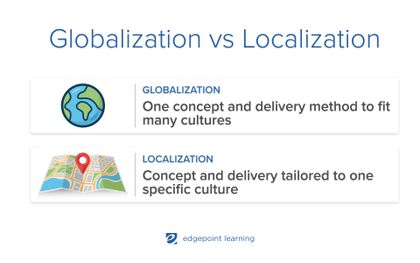How To Manage eLearning Localization For Global Employees
Corey Bleich
🍿 5 min. read
eLearning localization is a crucial tool for building your global brand
You’ve done it! Your business has expanded and now has offices across the globe. This was no easy task, but the work is just starting. For example, have you considered what this means for training and managing employees across languages and cultures? Thankfully, eLearning localization is a crucial tool for building your new global brand. Here's what you should know.
What we mean: globalization vs. localization
There is a general understanding that the world is becoming more interdependent—more global. While we are connected across the world now more than ever, though, a broad application of concepts is not always the best action when it comes to learning for your employees. Instead, when you're designing training materials, choosing between globalization vs. localization depends on what your goals are.

Globalization takes one particular concept and adapts it so that it fits across many different cultures. Localization does exactly the opposite: resources are tailored to one particular place or culture.
At a practical level, eLearning localization keeps employees safe. An estimated 25% of employee accidents are caused by a language barrier. And, a thoughtful approach to localizing your content demonstrates respect for what all employees bring to your business and indicates a desire for everyone to both understand and be understood.
Which one should I use?
If you are trying to communicate a shared company culture, globalization might be the best choice, but if you want to explain a particular process or procedure in a more direct way, localization is probably your move.
Globalization vs. localization can be a both/and proposition, though. And your work and your trainings will likely include both approaches.
Beyond translations: Best practices for eLearning localization
Of course, you should translate every eLearning course in your training to the local language—that’s a basic first step. But eLearning localization goes well beyond that. A word-for-word translation is clunky and a lot gets lost in, well, translation.
The goal of eLearning localization also includes changes to multimedia graphics, videos, and even voice narrators. In practice, it’s really about respect, safety, and inclusion for all of your employees.
Remember to keep in mind your goals for training: engaged, informed, and responsive employees. A course without eLearning localization may cause employees to check out, withdraw, or even be insulted by the content.
Here are eight best practices for eLearning localization to make sure everyone gets the support and knowledge they need.
1. Streamline your courses
Streamlining your courses does not mean “dumbing it down” or changing the crucial information it contains. Streamlined courses mean they have fewer multimedia elements (e.g., videos, graphics, and animations) that might be challenging (and costly) to localize.
Yes, video is great and engaging, but it doesn’t always cross cultures well. A character giving a thumbs up in the U.S. has just deeply insulted your employees in Iran. Keep what is culturally neutral, and eliminate the rest to make your job a bit easier.
You'll also decide if you want to launch a text-only or narrated course. Obviously, you'll face higher development costs if you're contracting with multiple voice actors from different regions versus relying on text-only translations, but the benefits may be worth it for your team.
2. Check your tech
Before you engage eLearning translation services or go any further in your course design, check in with your LMS to make sure it can handle specific language characters or fonts you might use.
For example, the Cyrillic alphabet (supporting languages like Russian and Czech) is going to use very different characters than the Roman alphabet used by many European languages. It will save you time and money to select fonts that support every character and symbol you will use in your global courses.
3. Get rid of what doesn't translate
Review your training materials for jargon, slang, and idioms that will make your content hard to understand across the languages.
If the language of your developers is different from the people receiving the training, take the time to have a culturally knowledgeable bilingual speaker review the materials for clarity.
4. Think beyond the language
As you go through and check for casual or colloquial usage that might make your course hard to understand, don’t forget about dialects. Language is complicated and complex, and dialect can dramatically change from one region to another.
5. Double check symbols, graphics, and colors
We might think that graphics and visual symbols are universal, but that’s just not so. Check your symbols (i.e., non-verbal signs and symbols) to make sure they make sense and are appropriate in the target language. (Think back to the thumbs-up sign we just discussed which is often used in interactive activities or pros/cons lists.)
Consider also color choice. Colors mean different things from culture to culture. In India, red has positive associations like love, wealth, and beauty. Head west to South Africa, and red is the color of grief and mourning.
6. Plan for accessibility
Accessible eLearning programs are a crucial part of eLearning localization. From captions to audio, make sure eLearning localization takes into consideration the needs of all employees across the world.
7. Make sure expanded text will fit on screen
Likewise, another design consideration is to make sure that expanded text and translations will still fit on screens, from mobile devices to desktops. Courses could as much as double in size with each new language.
Training needs to be available just-in-time for employees, and that might mean tweaking the design and course structure to fit all of the elements they need, wherever they are.
8. Build in extra time for development
Culturally responsive eLearning localization takes time. If you are building a new course from the ground up, expect to spend more time in development for each aspect of the course.
Planning ahead helps. Try these tools to cut down development time for new courses:
- Leave space in your design for longer translations
- Keep all of your source files accurate and current (helps with translations later)
- Put repeated phrases or button text in a template (for easy changes later)
- Contract with a high-quality translator for text and/or narration support
Further, consider who you’re using to perform your voiceover work. For example, if you were recording a course for a Mexican audience, having a Brazilian narrator would be jarring and obviously incorrect for that region’s Spanish dialect. As much as possible, find voiceover talent native to the area the course will be released in.
Even as global communication expands, eLearning localization contracts. And, adapting your training for new employee trainings in other countries can be challenging.
EdgePoint can help with eLearning consulting, co-development, and custom development that helps you meet your team right where they are. We work with global translators to get your course done right.
Get in touch to see what we can do for you.
